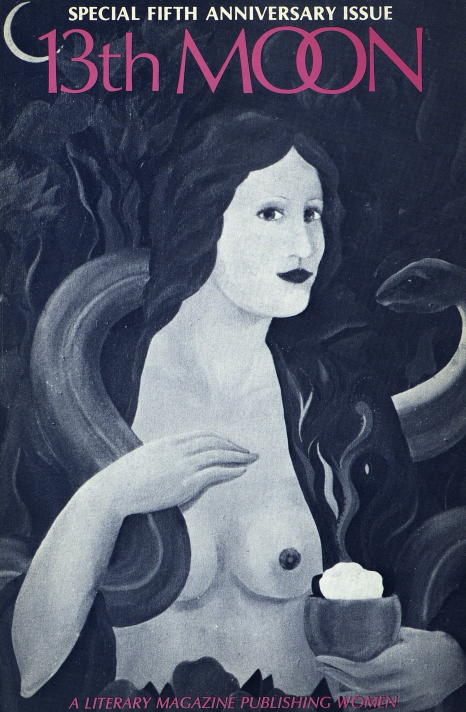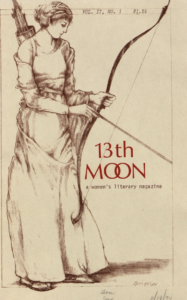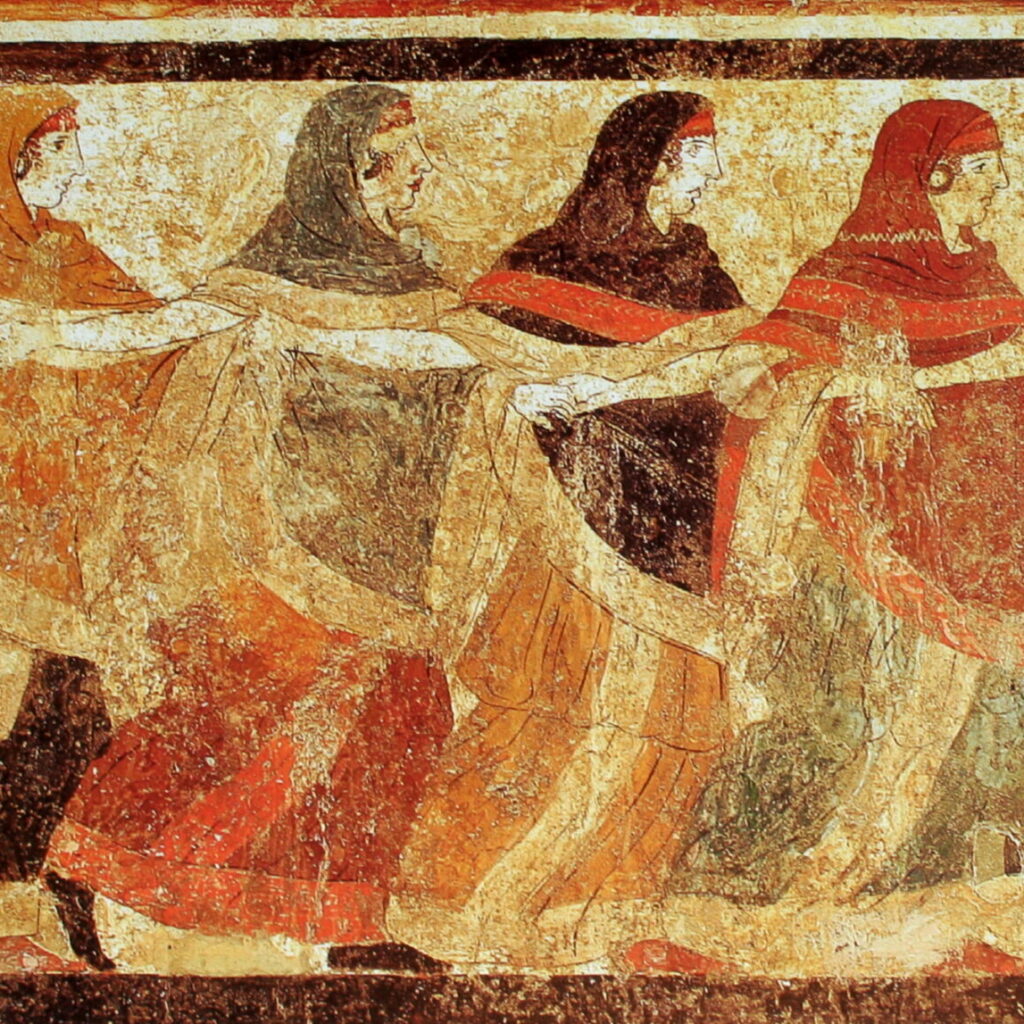Written by: Jaylin Barrett
November 08, 2023
“13th Moon is a woman’s literary magazine publishing work by women whoever they choose to be.”
13th Moon Mission Statement
Cover Story
As someone who keeps a look out for the unseen, incomprehensible, near-Delphic musings that spring from somewhere deep down in the psyche, something about 13th Moon immediately caught my eye.
13th Moon was a feminist literary magazine that was founded in 1973 and remained in print until 2005. Originally, the magazine was funded by the Graduate Student Council of the City College of New York, but as time went on, the magazine evolved and became an independent publisher in its own right.
Under the leadership of its first editor, Ellen Marie Bissert, 13th Moon Inc. went on to publish collections such as “Women Poets in Pre-Revolutionary America” (with an article about it in their 1979 issue) and other uniquely feminine tellings, like “The Immaculate Conception of the Blessed Virgin Dyke” (by Bissert, 1977) and “For the Furies” by Marge Piercy (1982).

The first cover of 13th Moon that I ever came across seemed to me to depict a biblical Eve, reclaimed.* It was for the Fifth Anniversary Issue: Volume 4, Issue 1 and designed by Louise E. Franklin.
On the cover she stares back, exposed yet empowered, holding the forbidden apple in one hand, now garnished with a blossom, smirking as a snake wraps around her like a friend rather than a threat. Immediately upon seeing it, I was charmed (much like the snake seemed to be).
In this telling, Eve isn’t a representative of oppositional defiance. Instead, she is someone who knows what she wants—who speaks up and receives.
*Interestingly, the cover art is in fact titled Cybele, who was a “mother” goddess in ancient Anatolia (modern-day Turkey).
Symbols of Femininity: Why the Name “13th Moon”?
The second print cover of 13th Moon features Artemis, the Greek goddess of the hunt, as one can tell by the bow and arrow.

13th Moon eventually evolved into its own press, but before this, they first attempted to publish under the name Artemis Press. They chose Artemis due to her connection with the winter solstice, “literally the thirteenth moon,” and her ties to fertility and agriculture, or “new growing cycle[s]” (as they wrote in the editorial statement for their second volume).
Artemis is often represented by the crescent moon. Throughout many cultures, there have been different variations on whether the moon is feminine or masculine. In Slavic mythology, the moon is masculine and “the sun is almost always thought of as a bride or maiden” (Britannica). However, in Egyptian mythology, Ra commands the sun, and in Greek mythology, it is Apollo, Artemis’s twin, who drives the sun into the sky on his golden chariot.
In China, the yin yang symbol is a more abstract way to represent this concept. The light, or “yang,” represents the masculine side, while the dark “yin” attributed to night is considered to be feminine. The symbol isn’t split into binaries and instead recognizes the balance of the two, showing some masculine in the feminine and vice versa. According to Nurturing Your Divine Feminine (nih.GOV):
“Yin problems tend to be ones of deficiency and usually involve the interior, while yang problems tend to be ones of excess and generally involve the exterior. Here’s the interesting part: There is nothing that is absolutely yin or absolutely yang; each is relative to the other, and everything contains components of both! As shown in the yin-yang symbol, there is always a seed of yin within yang and vice versa. Along this line of thought, all males have some feminine aspects and all females have some masculine aspects.”
Similarly, some Indian traditions also include a more harmonious view of the masculine and feminine, assigning each a sound created by the tanpura and playing them to create Ardhnarishwar, or a seamless melding between the two energies. Click here to hear one version. 😊
I came across 13th Moon as a student at George Mason University.
In January 2023, I started up an internship at The Narrative Transformation Lab, or TNT Lab, as we like to call it here. The way I see it, The Narrative Transformation Lab recognizes that everyone is their own stick of dynamite. One stick, one story alone, can certainly make an impact, especially if it’s well placed. And when going up against Everests like constructs of race, class and gender—in a word, when going up against systemic conflict—the more firepower, the better.
As part of the internship, I was tasked with writing a “Rabbit Hole”—a winding, meandering look at a narrative topic of my choosing.
I chose to research 13th Moon because I believe the contributors would agree that the more narratives at the ready, the better equipped we are to confront stereotypes about gender on both a personal and societal level.
There is fight here, in the pages of 13th Moon, and in its history. By telling their stories and publishing countless others, the editors and contributors of 13th Moon gave voice to the lives the writing, and the art of women, pushing back at anyone who might think that women’s voices should remain unheard.
In the Editorial for their Fifth Anniversary Issue (Vol. 4, No. I), the editors of 13th Moon explain their name, their goals, and who they are.
It is with their words that I invite you to follow me down this winding rabbit hole on the work of 13th Moon and all it inspires in my own journey…

I. Women, Becoming
“13th Moon was founded to provide a forum for the diversity of literature being produced by women today.” (From 13th Moon‘s mission statement)
Fresco of dancing Peucetian women from the Tomb of the Dancers in the Corso Cotugno necropolis of Ruvo di Puglia (circa end of the fifth century BC or mid-fourth century BC). Held at the Naples National Archeological Museum.

II. Women Moving Through Time
“The title is derived from the lunar calendar, which has thirteen months. It commemorates the time when the moon, as mediator of our bodies’ rhythms, was the symbol of spiritual transformation. It celebrates the opening of an age when we are in full control of our energies.” (From 13th Moon‘s mission statement)
Image: Cover of 13th Moon‘s special issue on “Narrative Forms” (Volume 8, No. 1 & 2, 1984). Cover art: The Vigil by Gina Gilmour.

III. Women in Music: The Personal and the Political
“The goal of 13th Moon is to strengthen a women’s sensibility in literature. 13th Moon is feminist in the general sense of being concerned exclusively with the work and viewpoint of women. Although the staff recognizes the interdependence of politics and culture, 13th Moon places primary emphasis on the writing of women rather than on political issues.” (From 13th Moon‘s mission statement)

IV. Celebrating Women Celebrating
“13th Moon is a literary magazine publishing women, whoever we choose to be. We hope that by exploring the special relationship women have to themselves and to the world, we will discover literature that is unique, that is female—that is ours.” (From 13th Moon‘s mission statement)
Image: Kristina McGrath’s poem “The Visit,” published in 13th Moon (Volume 8, No. 1 & 2, 1984)
In the end, when reading through 13th Moon, I found myself thinking most not about the works, but about the women who wrote them.
When you look through the archive of 13th Moon, I challenge you to look up one or two of the women whose works you read. Many are painters and professors as well as poets, and their stories both inspire and cause heartbreak, especially when it comes to the impact of their actions versus their name recognition.
When I undertook this exercise, many names led me to obituaries. Yet, I was not sad. Many of these artists may be gone, but their words are here. They’re alive in these pages, and I’m so thankful our paths have crossed.
While I am enthused by the fact the publication sprang from an independent press, it is also bittersweet in a way. Though the full archive of 13th Moon may be available online—and open-access, to boot—how many people know to look for it? How many are likely to come across it, tucked away as it is in an academic database like JSTOR? And it’s even harder to find these words in print.
However, as shown by the case of The Marvelettes, which I discussed in “Women in Music,” ownership over your work is everything, and so is celebration and recognition for it.
I’m so glad these women got the chance to publish their work, to have it be acknowledged, felt, and loved by others, all while remaining rightfully theirs. Per the 13th Moon policy, “the poem retains ownership to the author immediately after publication” (Vol. 2, No. 1).
To say that sharing one’s experiences gives you a better picture of who a person is would be selling it short. When you are vulnerable and share your story and emotions, and when you open your heart to others—whether that be through music and poetry or making the best brownies ever tasted—you share a part of yourself. You share a part of your soul.


Author Bio
Jaylin Barrett is a fourth-year Honors College student pursuing a Peace and Conflict Analysis major with a concentration in Political and Social Action. Jaylin was also a 2023 Peacebuilding Fellow at the Carter School.
Since coming to George Mason University, her research has been focused on domestic issues ranging from misinformation in the press, partisan divides, and structural oppression. With interests in communication, counter-culture, and the arts, she hopes to investigate more about the stories, pictures, and media that inspires people to take action and change their reality. Ultimately, she aspires to combine her knowledge of conflict and her interests by building spaces for creative expression and unity within communities.
How to Cite This Rabbit Hole
Barrett, Jaylin. (2023, November 08). “13th Moon: Rediscovering a legacy made by and for women.” The Narrative Transformation Lab. https://tntlab.carterschool.gmu.edu/discover/rabbit-holes/13th-moon-rediscovering-a-legacy-made-by-and-for-women/
Further Reading
13th Moon. (n.d.) Wikipedia. Retrieved August 27, 2023, from https://en.wikipedia.org/wiki/13th_Moon.
About Audre Lorde. (2021, February 17). The Audre Lorde Project. https://alp.org/about/audre.
Audre Lorde. (n.d.) Poetry Foundation. https://www.poetryfoundation.org/poets/audre-lorde.
Bat mitzvah at 100. (2022). Jewish Women’s Archive. https://jwa.org/batmitzvah100.
Bissert, E. M. (1974). Editorial. 13th Moon, 2(1), 3. https://www.jstor.org/stable/community.28031928.
Bissert, E. M. (1979). The immaculate conception of the blessed virgin dyke. 13th Moon, 2 and 3(1), 39–41. https://www.jstor.org/stable/community.28031929.
Bissert, E. M., McCann, K., & Renfro-Mazzatti, S. (Eds.). (1974). 13th Moon, 2(1). https://www.jstor.org/stable/community.28031928.
Bissert, E. M., Rook J. V., & Stivelband J., et al. (Eds.). (1978). Special fifth anniversary issue. 13th Moon, 4(1). https://www.jstor.org/stable/community.28031931.
Bissert, E. M., & Hacker, M. (Eds.). (1983). Working class experience. 13th Moon, 7(1&2). https://www.jstor.org/stable/community.28031935.
Bissert, E. M., & Hacker, M. (Eds.). (1984). Narrative forms. 13th Moon, 8(1&2). https://www.jstor.org/stable/community.28031936.
Bissert-Helinka, E. M., Hacker, M., & Johnson, J. E. (Eds.). (1993). Special folios: Italian women writers and feminist fiction(s). 13th Moon, 11(1&2). https://www.jstor.org/stable/community.28031939.
Bissert-Helinka, E. M., Hacker, M., & Johnson, J. E. (Eds.). (1993). Special focus: Writings by Caribbean women. 13th Moon, 12(1&2). https://www.jstor.org/stable/community.28031940.
Bissert-Helinka, E. M., Hacker, M., & Johnson, J. E. (Eds.). (2002). 13th Moon, 17(1&2). https://www.jstor.org/stable/community.28031945.
Cowell, P. (1979). Women poets in pre-Revolutionary America, 1650-1775. 13th Moon, 4(2), 47-65. https://www.jstor.org/stable/community.28031932.
Curtis-Horsfall, T. (2023, May 24). Inside Karen Carpenter’s final ever performance and days leading to her tragic death. Smooth Radio. https://www.smoothradio.com/artists/carpenters/karen-carpenter-final-performance-death/.
Cybele. (n.d.). Wikipedia. Retrieved August 27, 2023, from https://en.wikipedia.org/wiki/Cybele.
Dore, M. (Dir.). (2014). She’s beautiful when she’s Angry [Film]. Music Box Films. See: http://www.shesbeautifulwhenshesangry.com/.
Dorothy Pitman Hughes. (n.d.). Wikipedia. Retrieved August 27, 2023, from https://en.wikipedia.org/wiki/Dorothy_Pitman_Hughes.
Emmeline Pankhurst. (n.d.) Wikipedia. Retrieved August 27, 2023, from https://en.wikipedia.org/wiki/Emmeline_Pankhurst.
Federico, C. (2002). Words words words. 13th Moon, 17(1&2), 6-8. https://www.jstor.org/stable/community.28031945.
Finger, A (1980). Basic skills. 13th Moon, 5(1 & 2), 37-47. https://www.jstor.org/stable/community.28031933
Friedan, B. (1963). The feminine mystique. W. W. Norton.
Gasparini, E. (n.d.). Folk conceptions. Encyclopædia Britannica. Retrieved August 27, 2023, from https://www.britannica.com/topic/Slavic-religion/Folk-conceptions.
Gloria Steinem. (n.d.). Wikipedia. Retrieved August 27, 2023, from https://en.wikipedia.org/wiki/Gloria_Steinem.
Gonzalez, M. (2016, June 4). The quinceañera, a rite of passage in transition. The New York Times. https://www.nytimes.com/2016/06/05/nyregion/the-quinceanera-a-rite-of-passage-in-transition.html.
Hilton, M. (2014). Bar mitzvah, a history. Philadelphia: Jewish Publication Society.
Holahan, S. (1978). A woman, moving. 13th Moon, 4(1), 5-6. https://www.jstor.org/stable/community.28031931.
Honorees 2019: Cherie Federico. (n.d.). University of the Arts London. Retrieved June 1, 2023, from https://www.arts.ac.uk/people/honoraries/honoraries-2019/cherie-federico.
John, M. (2015). Gloria Steinem: Black women created the feminist movement. Good Black News. https://goodblacknews.org/2015/08/08/gloria-steinem-black-women-created-the-feminist-movement/.
JSTOR. (n.d.). 13th Moon archive. Independent Voices. https://www.jstor.org/site/reveal-digital/independent-voices/.
Lavender menace action at Second Congress to Unite Women. (n.d.). NYC LGBT Historic Sites Project. Retrieved June 1, 2023, from https://www.nyclgbtsites.org/site/lavender-menace-action-at-second-congress-to-unite-women/.
Le Guin, U. K. (2016). Words are my Matter: Writings about life and books, 2000-2016. Small Beer Press.
Lewis, A. (2023, January 20). The true story behind Princess Diana’s revenge dress. Reader’s Digest. https://www.rd.com/article/story-princess-dianas-revenge-dress/.
Matthews C. M. (2017, December 11). Nurturing your divine feminine. Proceedings (Baylor University. Medical Center), 24(3), 248. https://doi.org/10.1080/08998280.2011.11928725.
McGrath, K. (1984). The visit. 13th Moon 4(1), 32-33. https://www.jstor.org/stable/community.28031931.
Morales, C. (2022, June 30). Family recipes etched in stone. Gravestone, that is. The New York Times. https://www.nytimes.com/2022/06/30/dining/gravestone-recipes.html.
Muñoz, J. (2021, February 4). The powerful, complicated legacy of Betty Friedan’s ‘The Feminine Mystique’. Smithsonian Magazine. https://www.smithsonianmag.com/smithsonian-institution/powerful-complicated-legacy-betty-friedans-feminine-mystique-180976931/.
Mylod, M. (2022, November 8). The menu [Film]. Searchlight Pictures.
Perrone, P. (2010, August 2). Tony Peluso: Guitarist whose solos on The Carpenters’ “Goodbye to Love” ushered in the power-ballad era. The Independent. https://www.independent.co.uk/news/obituaries/tony-peluso-guitarist-whose-solos-on-the-carpenters-goodbye-to-love-ushered-in-the-powerballad-era-2041048.html.
Pettis, R., & Winant, F. (2005). [Biography]. glbtq, Inc. http://www.glbtqarchive.com/literature/winant_f_L.pdf.
Piercy, M. (1982). For the furies. 13th Moon, 6 (1&2), 5-7. https://www.jstor.org/stable/community.28031934.
Please Mr. Postman. (n.d.). Wikipedia. Retrieved September 5, 2023, from https://en.wikipedia.org/wiki/Please_Mr._Postman.
Radicalesbians. (1969). The year of gay liberation. New York Public Library Exhibition Archive. http://web-static.nypl.org/exhibitions/1969/radicalesbians.html.
Steinem, G. (2016). My life on the road. Penguin Random House.
The Feminine Mystique. (n.d.) Wikipedia. Retrieved August 27, 2023, from https://en.wikipedia.org/wiki/The_Feminine_Mystique.
Tinker, C. (1984) Cuentos: Stories by Latinas. 13th Moon, 8(1&2), 235-237. https://www.jstor.org/stable/community.28031936.
uDiscover Team. (2020, August 26). Led Zeppelin. uDiscover Music. https://www.udiscovermusic.com/artist/led-zeppelin/
uDiscover Team. (2020, June 28). Ringo Starr. uDiscover Music. https://www.udiscovermusic.com/artist/ringo-starr/
uDiscover Team. (2020, April 27). The Who. uDiscover Music. https://www.udiscovermusic.com/artist/the-who/
uDiscover Team. (2020, February 6). The Beatles. uDiscover Music. https://www.udiscovermusic.com/artist/the-beatles/
uDiscover Team. (2022, December 27). The 100 best drummers of all time. uDiscover Music. https://www.udiscovermusic.com/stories/best-drummers-in-music/.
Winant, F. (1974). Collected works. 13th Moon 2(1), 40. https://www.jstor.org/stable/community.28031928.
Yanagihara, H. (2023, April 20). This woman’s work. The New York Times Style Magazine. https://www.nytimes.com/interactive/2023/04/20/t-magazine/women-artists-culture-mentors.html.


